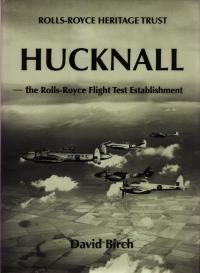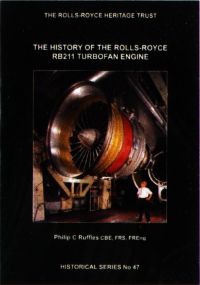Rolls-Royce Heritage Trust
Historical Series Reviews - Page 06
 |
Hucknall
The Rolls-Royce Flight Test Establishment
by David Birch
Hardbound, 304mm x 215mm x 29mm, 424 pages
ISBN: 978-1-872922-43-0
Rolls-Royce Heritage Trust
P.O. Box 31
Derby DE24 8BJ
England
Recommended Retail Price: £45 R-RHT Members, £60 non-members
Please see Book List/Order Form
562 B/W photos/illustrations |
Reviewed by Kimble D. McCutcheon, 19 July 2017
Hucknall is the kind of book that technical history enthusiasts dream of. Full of intriguing technical details, it chronicles a 36-year span of innovation in aircraft engine installation and systems integration. It tells the story of the people behind this innovation, their hard work and clever approaches to solving problems. It may be the best organizational history I have ever read. The author spent his early career at Hucknall and his fondness for the place and its people is evident on every page. He is especially complimentary of Ray Dory, who managed the work at Hucknall for many years. This large-format hardbound book maintains the usual high R-RHT construction standards and is lavishly illustrated with photographs, tables and charts that are wonderfully captioned.
Rolls-Royce's interest in engine installation issues dates back to WWI, when R-R found that aircraft manufacturers often did not know as much about installing engines as they thought they did. In order to protect its engines, R-R became increasingly involved in engine installation and systems issues, eventually creating its own flight test establishments. The first of these was at Stag Lane, Edgeware, north London, where, in cooperation with de Havilland, R-R tested its Falcon X (later Kestrel) in a de Havilland DH.9A during late 1927 and early 1928. R-R was pleased with the Stag Lane success, but wanted complete control over the testing. With this in mind, a new flight test organization was established at Tollerton, near Nottingham. Tollerton had hangars and aircraft servicing facilities, but no offices, which required any engineering staff to commute from Derby. Work at Tollerton was so successful that by 1934 R-R had outgrown the facility and began looking for a place where the many test aircraft, development programs, and ancillary services could be collocated. R-R took over and refurbished the Mansfield Engineering Company's premises at Hucknall in late 1934 and by early 1935 had transformed it into a full-fledged flight test establishment, which remained in operation until 1971.
Chapter One acquaints the reader with terminology and concepts used in the remainder of the book. It also highlights R-R's key role in introducing many of these technologies to the world. In this reviewer's opinion, this outstanding chapter alone is worth the book's price. For piston engines, its topics include the
- difference between powerplants and engine installations
- development of flame-damping exhaust systems that produced jet thrust
- development of cooling systems, coolant radiators and header tanks
- development of oil systems and oil coolers
- development of fuel, carburetion, fuel injection, air intakes and induction systems
- development of automatic engine controls
- development of magnetos and sparking plugs
- adoption of adjustable-pitch, variable-pitch and constant-speed propellers
- flight test procedures, data collection and analysis
For gas turbines, its coverage includes
- the often-tricky integration of the engine, airframe, jetpipes, thrust reversers and noise reducers
- fuel systems
- performance
Chapter Two, after discussions of work at Stag Lane and Tollerton, presents a year-by-year account of work at Hucknall from 1935 until the Establishment was closed in early 1971. This 197-page section is a delight, with in-depth discussion of the major programs and their technologies. One can follow the progress of numerous technical aspects, not to mention the inestimable contributions of Hucknall to Britain's WWII effort as it improved scores of aircraft types to address new threats, increase performance and enhance reliability. I cannot overstate the amount and quality of information presented here as it provides exceptional insight into just how much went into winning WWII, preparing for the Cold War, and ensuring the progress of civil transportation.
Chapter Three is dedicated to other non-flight-test work taken on by Hucknall, such as maintenance, repair and modification of service aircraft, wartime powerplant production and engine modification. Hucknall also, among other things, assembled a few airborne radar units, experimented with ground position indicators, developed a radio-controlled torpedo, and manufactured rocket thrust chambers.
Chapter Four provides an overview of the many ground test facilities that Hucknall developed and used. These included
- test rigs that simulated installation and environmental conditions to which the engines were subjected
- static testbeds for propeller, piston engine and gas turbine engine development testing
- anti-icing test facilities
- several wind tunnels
- VTOL experimental facilities
- noise absorption test rigs
Appendices comprise another 144 pages of the book, and provide a wealth of detailed information that supplements the other chapters.
- Appendix 1A – Flight Development Aircraft. An annotated list of all development aircraft.
- Appendix 1B – Repairs, Conversions and Modifications. Details of work performed.
- Appendix 1C – Aircraft Received for Investigation Into Problems. Details of each case.
- Appendix 1D – Other Aircraft. Minor work, uncompleted conversions, non-R-R tests.
- Appendix 1E – Communications and Liaison Aircraft. Used for site visits and executive shuttles.
- Appendix 1F – Accidents and Incidents. Details of each.
- Appendix 2 – Powerplant Production. Powerplants designed, produced or supervised by Hucknall.
- Appendix 3 – Flight Development Engines. Installed in Hucknall aircraft for development. Work with Buzzard, Kestrel, Goshawk, Merlin, Peregrine, Exe, Vulture, Griffon, Eagle, Allison V-1710, Daimler-Benz DB601, W2B/23 Welland, RB37 Derwent, RB39 Clyde, B41 Nene, RB50 Trent, RB53 Dart, RB93 Soar, RB65 Avon, RB80 Conway, RB90 Avon, RB108, RB109 Tyne, RB146 Avon, RB163 Spey, RB168 Spey, RB211 and Gazelle types is described.
- Appendix 4 – Personnel. Managers, test pilots, observers, departments.
- Appendix 5 – Contracts. Listing of Air Ministry contract numbers.
- Appendix 6 – Miscellaneous. Demonstration flights, flying hours by year and engine type.
- Appendix 7 – Chronology. First flights and other noteworthy events.
The Index includes aircraft, engines, performance evaluations, installation systems/components, development disciplines, descriptions, test facilities, companies, places, personalities, memoranda, miscellaneous, illustrations, abbreviations and conversion factors.
As with all R-RHT publications, Hucknall is a great value. This reviewer highly recommends it.
 |
The History of the Rolls-Royce RB211 Turbofan Engine
by Philip C Ruffles
Softbound, 295mm x 210mm x 20mm, 326 pages
ISBN: 978-1-872922-48-5
Rolls-Royce Heritage Trust
P.O. Box 31
Derby DE24 8BJ
England
Recommended Retail Price:
Please see Book List/Order Form
335 photos/illustrations
|
Rolls-Royce Heritage Trust Historical Series No.47
Reviewed by Douglas Culy, 16 January 2015
This history is one of the larger books published by R-RHT, and is really a history of Rolls-Royces three-shaft engines:
- RB178 demonstrator engine — one built
- RB203 for the Fokker 228 — five built
- RB211-6 — sized for initial concept of the L-1011
- RB211-22 — sized for redefined installation in the L-1011 that started development
- RB211-524 — for B-747 and growth L-1011
- RB-211-535 — for the B-757
The newer Trent programs are mentioned as descendants of the RB211 but not discussed in detail.
The book has a very large amount of detail, and is a blow-by-blow account of taking engine power from the subscale RB203 Trent II's 9,730 lb-t to the RB178-16 demonstrator at 24,750 lb-t to the RB211-6 at 33,500 lb-t (at most), to the RB211-22 at 40,000 lb-t (only for a few seconds, so as to avoid cremating the engine, while these early -22s averaged about 35,000 lb-t), to the RB211-22B averaging 38,500 lb-t versus a commitment to Lockheed of 38,000 for flight-test engines (the production contract was for 40,600 lb-t) to the RB211-22C at 42,000 lb-t, to the RB211-524B at 50,000 lb-t, to the RB211-535C at 37,400 lb-t, to the Trent 600/700 at 67,500 lb-t, to the Trent 800 at 91,600 lb-t, to the Trent XWB at 93,000 lb-t, and to intermediate powers for other Trents, obtained by scaling the core. After the -22C program, the challenges were easily handled, but Ruffles shows the -22 and -22B to be the engines that almost killed Rolls-Royce.
Ruffles was a development engineer, given varied responsibilities at increasingly higher levels in the Company, having joined R-R shortly before the start of studies leading to the RB211. He was intimately involved in the RB211 program. He shows that the Hyfil composite fan blade was only the 'straw that broke the camel's back' (the low-pressure-compressor vanes and the front bearing housing were also glass-reinforced plastic). The larger problem areas were: burning of the combustor, high-pressure (HP) turbine nozzles (limiting turbine inlet temperature) and HP turbine blades; and excessive leakage through most of the labyrinth seals between the three rotating spools and the static structure. Ruffles then tells of the long effort to resolve field problems, since the test hours were not sufficient to find the really short-life components. The discussion of these major problems and their solutions is thoroughly done in terms of the detail design aspects of several features of each of the suffering parts.
The usually ordinary problem of weight was complicated by having to add much weight to move the engine mounts from the core-engine case to the fan case. Accommodating airframe weight growth came after the R-R bankruptcy.
Bankruptcy was brought about by cost growth in the program, sales decline of R-R overall business, admittedly poor management of development, the need to force Lockheed to come to terms on modifying a contract that had become impossible to meet, and R-R's poor cash position after just completing development of the Adour engine. Though not mentioned in the book, R-R was ALSO working on the: civil and military Speys, the RB193 for the VAK191 fighter (which was cancelled just after the bankruptcy), RB199 program (which was started before the -22 version had begun and continued after bankruptcy). Total company sales in 1968, the year of the RB211 program start, was near 60 million pounds, and investment in the 211 program by the time of bankruptcy filing was near 200 million pounds. Inflation and real material/labor increases had raised the cost of production engines by 69%. The book separately uses the terms "Launch Costs" and "R&D Costs". They are not differentially defined, but this reviewer thinks that R&D means engineering development alone, and Launch includes manufacturing tooling and possible initial spares.
Ruffles shows that R-R had good intelligence on what competitors Pratt & Whitney and General Electric were doing, and that this in turn motivated R-R to push harder on its programs. Many participating engineers and managers are discussed and shown, suggesting to this reader that frequently changing leadership contributed to management problems.
In summary, the history of the RB211 is very much a handbook for the development engineer, and the most detailed history of a development program that this retired development engineer has seen since he entered the business 54 years ago.
However, The History of the Rolls-Royce RB211 Turbofan Engine is a complex book, requiring several reads to grasp all that is included, a task is greatly complicated by the LACK OF AN INDEX. This reader encountered many small glitches in the book (typos, misspellings, etc.). Ruffles made a number of comments that assumed the reader was well acquainted with R-R facilities and their uses. He also naturally used British vernacular, some of which is very hard for Americans to understand. The writing seemed to have been hurriedly done, and the editing was sloppy or non-existent.
In spite of the above problems, this reader still highly recommends the book … with the caveat: be warned.

